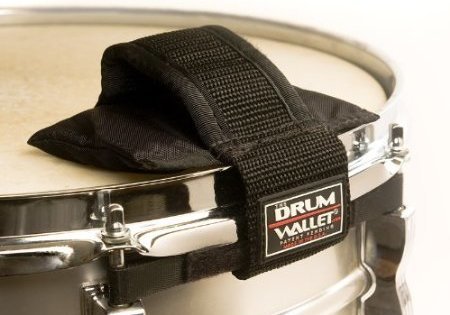
I heard about the The Drum Wallet while attending NAMM and was really interested in checking this product out!
The Drum Wallet is a simple muffling device for the snare drum that enables the user to apply the muffle or remove it on the fly. Having the capability of snare tone management on the fly appeals to me since I like to play songs that cover more than one style.
Installing The Drum Wallet on the snare drum was pretty easy. The product shipped with a short list of directions for application which I followed without any issues.
The Drum Wallet design is simple but clever. It’s simply modeled after a wallet (we’ve all used one to muffle a snare drum). The wallet is attached to velcro straps which get threaded around the snare drum’s tension rods. There is a wide sleeve attached to the wallet that enables a drummer to use a drum stick to manage the application on the fly. The fact that you can quickly lift The Drum Wallet on or off the snare drum is brilliant. When the wallet is placed on the snare drum it does a good job of muffling the drum’s tones without completely drowning the natural sound of the instrument. (Like the zero rings sometimes do.)

I was curious to see just how quickly I could add and remove the wallet on the fly. I attached The Drum Wallet to the left side of my snare drum and then immediately started playing while the camera was rolling. I attempted adding and removing the muffling device using both traditional and matched grips–all while keeping time. My first try was a little rough (as seen below). I soon realized that placing the wallet onto the drum takes slightly more coordination than removing it. Once I got the feel for that it was smooth sailing for both grips!
I’ve since taken The Drum Wallet with me on a few gigs and really like the flexibility of having multiple sounds for the snare drum. I’m also looking forward to using it in the studio. You can purchase one on Amazon or on The Drum Wallet’s website. For more information you can check out thedrumwallet.com.
